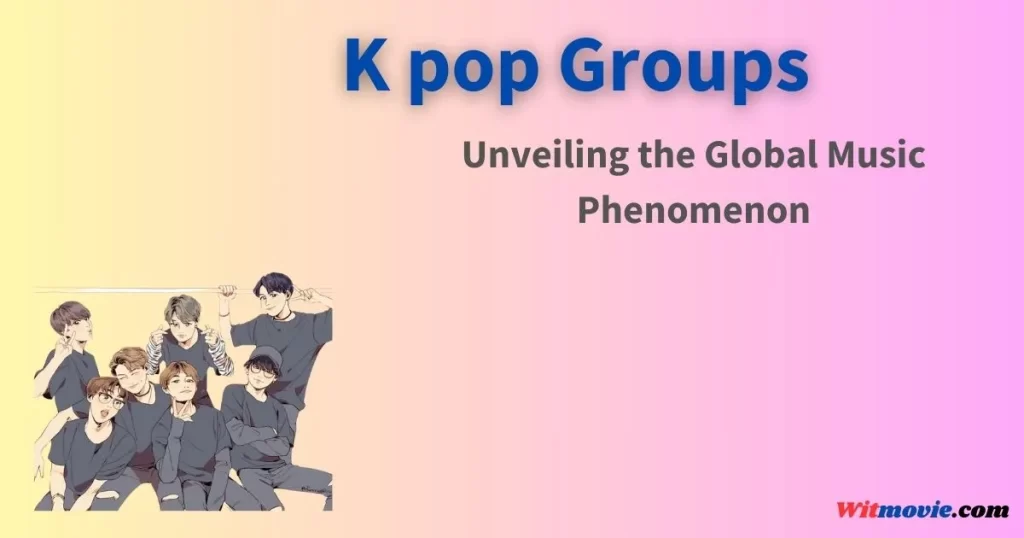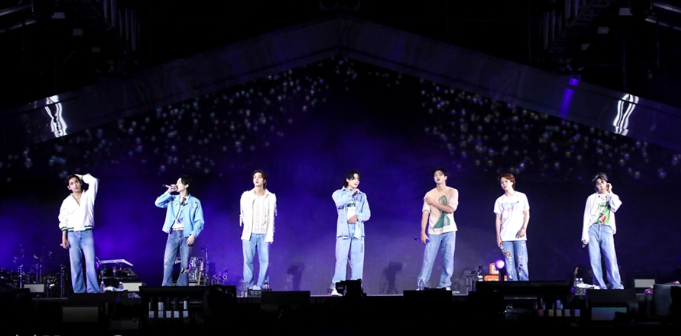K pop, a musical genre from South Korea, has evolved into a global phenomenon, transcending cultural and linguistic barriers to captivate music lovers worldwide.
Characterized by various audiovisual elements, the genre is about music, fashion, choreography, and overall presentation.
The industry is known for its rigorous training system, where aspiring artists undergo extensive lessons in singing, dancing, and foreign languages before debuting as part of a group.
The rise of K-pop can be primarily attributed to the success of groups like BTS and Blackpink, whose international fame has allowed newer acts to enter the global stage.
With catchy melodies, intricate choreography, and polished images, K-pop groups dominate music charts and break records across various platforms.
While the music scene continuously evolves, several Kpop groups have cemented their status as cultural icons, influencing fashion trends and pop culture.
From the impact of the Hallyu wave across Asia to the genre’s infiltration into Western markets, K-pop groups remain at the forefront of an industry as dynamic as it is competitive.
History and Evolution of K-Pop

The rich tapestry of K-Pop is characterized by its unique blend of musical genres and global appeal. It grew from its South Korean roots to become a significant cultural phenomenon.
This section explores how K-Pop evolved through its origin, international recognition, and significant milestones attained by prominent groups.
Origins and Growth
In the wake of the Korean War, South Korea saw an infusion of Western music, igniting a passion that led to the birth of Korean pop, or K-pop.
Rock, hip-hop, and R&B flourished in South Korea during the late 20th century, providing the foundation for Kpop’s distinctive style.
The 1990s marked a definitive turn for the genre with the emergence of groups like Seo Taiji and Boys, whose integration of catchy melodies and danceable beats with traditional Korean music elements paved the way for future K pop acts.
- Key Influences: Western pop, rock, hip-hop, R&B
- Significant Decade: 1990s
- Pioneering Group: Seo Taiji and Boys
International Breakthrough
K pop’s reach began to extend beyond Japan, a close neighbor and one of its first international markets.
The growth of YouTube as a global platform for music videos played a crucial role in catapulting K-pop into the international arena.
Psy’s “Gangnam Style” became a global phenomenon, proving the genre’s worldwide appeal.
Groups such as Girls’ Generation, SHINee, and 2NE1 further popularized K-Pop internationally, achieving recognition on Billboard charts and international music awards.
- Catalyst for Global Reach: YouTube
- Notable Success: Psy’s “Gangnam Style”
- Key International Markets: Japan, Billboard Charting
K-Pop Groups Milestones
In the new millennium, K pop groups like BTS and BLACKPINK broke numerous records, solidifying K-pop’s position in the global music industry.
BTS became the first Korean group to top the Billboard 200 chart, while BLACKPINK’s music video for “How You Like That” set a record for the most views within 24 hours on YouTube.
Pioneers like BIGBANG and Girls’ Generation previously laid the groundwork for these newer groups, combining innovative music production and strategic social media use to engage fans worldwide.
- Record-Breaking Groups: BTS, BLACKPINK
- Innovators: BIGBANG, Girls’ Generation
- Achievements: Billboard 200, YouTube viewing records
K-Pop Groups and Identities

K pop groups reveal intricacies in their identities through music, performance, and styling. Crafting their unique identities, these groups intertwine choreography, fashion, and music videos to showcase their artistry. Below, the distinctive attributes of K-pop groups, the leaders in boy bands, and top girl groups are explored in detail.
Defining Features of K pop Groups
K pop groups are known for their vocal abilities and the elaborate choreography that characterizes performances.
Bold fashion choices further delineate their brand, creating iconic looks that resonate with global audiences.
High production value is evident in their music videos, which often go viral, cementing their status in popular culture. For example, BTS’s intricate dance routines and narrative-driven videos set a standard within the industry.
- Vocals: Exceptional singing with a mix of Korean and English lyrics.
- Choreography: Synchronized dance moves that become global trends.
- Fashion: Trendsetting styles that influence global fashion scenes.
- Music Videos: Cinematic visuals that support the group’s identity and narratives.
Notable Boy Bands
Boy bands like BTS, with their genre-defying albums, and NCT, which branches into sub-units including NCT 127, NCT Dream, NCT U, and WayV, showcase musical versatility and innovative concepts.
EXO stands out with its powerful vocals and sci-fi-themed narratives, while Stray Kids impresses with its self-produced tracks and impactful messages.
Bands like GOT7 elevate the industry with their onstage charisma and catchy hooks, and emerging groups such as TXT and NewJeans contribute to the evolving scape.
- BTS: Evolving with socially conscious themes and impactful storytelling.
- EXO: Melodious vocals blended with captivating conceptual content.
- NCT 127: Fusing hip-hop with experimental sounds.
Prominent Girl Groups
BLACKPINK’s fierce, bold style and electrifying performances set them apart in girl groups.
Twice captivates fans with catchy melodies and cohesive dance routines.
Groups like Red Velvet and (G)I-DLE offer unique sounds and visuals, with the latter showcasing edgier concepts.
aespa merges AI concepts with outstanding performances, while MAMAMOO is known for their powerhouse vocals and authenticity.
Pioneers like Girls’ Generation paved the way, inspiring groups such as ITZY, whose messages of confidence resonate with young audiences globally.
- BLACKPINK: Combining powerful performances with cutting-edge fashion.
- Twice: Harmonizing upbeat music with vibrant choreography.
- ITZY: Empowering themes wrapped in dynamic performances and daring fashion choices.
K-Pop Industry Dynamics

The K-Pop industry is characterized by its rigorous training regimes, strategic marketing approaches, and expansive global outreach, which create a unique ecosystem for producing and promoting Korean pop music.
This section delves into the critical role of entertainment companies, idols’ intensive training and development process, and the innovative marketing strategies that aid in their worldwide expansion.
The key statistics of K POP (US dollars)
- K-Pop industry valued at $10 billion (2021).
- BigHit Entertainment sales: $796 million (2020).
- BTS: Over 20 million albums sold in South Korea (2021).
- S.M. Entertainment turnover: ~$332 million (First half of 2021).
- 39% of K-pop YouTube views are from the Americas (2019).
- K-pop export value: $375 million (2019).
As of 2020, the K-pop industry’s estimated value is approximately $5 billion, substantially contributing to South Korea’s economy.
Role of Entertainment Companies
Leading entertainment companies such as SM Entertainment, JYP Entertainment, and YG Entertainment have been instrumental in shaping the K pop industry.
They’re not only talent hubs but also trendsetters in the industry, often involving:
- Comprehensive scouting and auditions
- Meticulous artist management
- Strategic branding and launch of groups
These conglomerates have cultivated some of the most successful acts to make it onto the Billboard Hot 100, showcasing the competitive edge of Korean pop music on a global stage.
Training and Development of Idols
Prospective K-pop idols often endure years of intense training.
Reputable companies run rigorous programs focusing on the following:
- Enhancing vocals and choreography skills
- Developing a multifaceted skill set to prepare idols for the spotlight
This training is crucial in ensuring that performers can meet the high standards of synchronized dance routines and vocal prowess that fans have come to expect.
Marketing and Global Expansion
Marketing strategies within the Kpop industry have played a key role in its global success. This involves:
- Leveraging social media platforms to interact with and expand fan bases
- Appointing idols as brand ambassadors to boost both visibility and credibility
Additionally, reality shows have become popular for showcasing idol development and attracting international viewership, further solidifying K-ㅔop’s position as a global cultural phenomenon.
Music Production and Aesthetics
In the competitive world of Korean pop, music production and aesthetics play vital roles in setting artists apart and defining their success. This section explores meticulous composition and lyricism, captivating visual and performance art, and the substantial influence of Western music genres within K-pop.
Composition and Lyricism
Kpop songs often involve a sophisticated blend of genres, including pop, hip-hop, R&B, and even rock elements, creating a distinctive sound that resonates globally.
Producers and musicians focus on crafting catchy hooks and melodies that aim for chart-topping appeal. The lyrics, sometimes written in multiple languages, are carefully woven to capture the diverse fan base. Meanwhile, distinctly Korean idioms and references maintain a unique cultural connection.
- Catchy Hooks: Critical for chart performance; often a blend of Korean and English phrases.
- Genre Blending: Commonly integrates pop, hip-hop, R&B, and electronic influences.
- Multilingual Lyrics: Increases the song’s accessibility and global reach.
Visual and Performance Art
The visual elements of K-pop, including music videos, fashion, and choreography, are as fundamental as the music itself.
Lavish and aesthetically rich music videos often feature cutting-edge fashion styles that inspire global trends. Meanwhile, the intricate choreography is not merely an addition but an essential part of the storytelling and artist’s expression. It heightens the emotional impact and engagement of the audience.
- Music Videos: Showcase high production value and creative storylines.
- Fashion: Often avant-garde, setting global style trends.
- Choreography: Intricate and expressive, crucial for live performances.
Influence of Western Music
Korean pop’s production intricately meshes Western influences with unique Korean elements. Pop and hip-hop from the West are particularly influential, adapted, and transformed to fit K-pop’s vibrant style.
Collaborations with Western artists and producers have become increasingly common, further integrating K pop into the global music landscape.
- Adaptation of Genres: Localizing Western pop and hip-hop styles to fit the K-pop mold.
- Collaborations: Serves as a bridge between K-pop and global music scenes.
- Cultural Integration: Balances Western influences with Korean culture in music production.
Fandom and Cultural Impact

The intricate relationship between K pop fandoms and cultural impact reflects a dynamic engagement with global audiences while promoting South Korean soft power.
This section explores how fan culture directly influences global engagement, the strategic deployment of K-pop as an instrument of soft power, and the role of fandom in social advocacy.
Fan Culture and Engagement
Fan Culture and Engagement form the heartbeat of the K pop phenomenon, with fans actively participating in various ways. They bond over shared interests on multiple platforms, especially:
- Social Media: Where they rally behind their favorite groups, organize streaming parties, and trend hashtags.
- YouTube: This virtual stage for K-pop idols’ performances reaches millions worldwide.
Aside from digital engagement, international fan meets, and concerts are prime examples of K-pop’s physical outreach. They foster a sense of community, transcending cultural and linguistic barriers.
K-pop as Soft Power
K pop’s influence extends beyond mere entertainment, as South Korea leverages its popularity to exert soft power. The government appoints prominent K-pop stars as cultural ambassadors to promote the country’s image abroad.
This strategic move enhances Korea’s cultural footprint and drives economic gains through increased tourism and interest in Korean products.
Social Issues and Advocacy
K-pop fandoms have grown into a potent force for social issues and advocacy. Their collective actions often mirror the progressive self-love and mental health messages propagated by K pop groups. For instance:
- Fans have organized and participated in campaigns worldwide to support various causes, from human rights to mental health awareness.
- The communal nature of the fan groups provides a supportive environment that emphasizes acceptance and self-care.
Moreover, fandoms occasionally use their considerable online presence to influence social change and voice collective opinions on critical issues, proving that K pop’s impact transcends mere entertainment.
Recognition and Achievements
In the competitive world of K-pop, certain groups have distinguished themselves through remarkable recognition and achievements that extend beyond South Korea’s borders.
These milestones include award-winning moments, record-breaking accomplishments, and indelible impressions of K-pop culture. This section will explore these aspects of K-pop groups.
Award-winning Milestones
K-pop’s reach is visible in the myriad awards collected by its artists. For example:
- MAMA Awards: Esteemed as one of the major K-pop awarding ceremonies, many groups have been recognized for their outstanding performances and albums.
- Music Show Wins: A first win on South Korea’s weekly music shows is a notable achievement badge for groups. It highlights their growing popularity and success within the industry.
Record-breaking Achievements
Groups have shattered records with their music chart performance:
| Chart/Record | Details |
|---|---|
| Billboard Hot 100 | K-pop groups have entered the chart, with Wonder Girls’ “Nobody” reaching No. 76 first. |
| Billboard 200 | Features several K-pop groups, highlighting their international album sales. |
| YouTube Records | K-pop groups quickly gain views, showing global appeal with their colorful and catchy music videos. |
Influence on Pop Culture
The cultural impact these groups wield is immense:
- Their music ranges from fierce, high-energy anthems to bubblegum pop, creating diverse sounds that appeal to many listeners worldwide.
- Choreography and fashion adopted by Kpop groups often set trends and become widespread among fans, demonstrating their significant influence on global pop culture.
Who is the most popular K pop group?
In the dynamic realm of K-pop, popularity can be measured by several indicators, such as album sales, streaming numbers, and global fan base presence. This section will briefly examine standout K-pop groups that have made significant international breakthroughs.
- BTS (Bangtan Sonyeondan): Known for their record-breaking achievements and immense global following, BTS reigns as one of the most influential K-pop boy groups. They have been pivotal in popularizing K-pop worldwide. With albums that continuously top charts and a presence that sells out arenas globally, their impact is unmistakable.
- BLACKPINK: As a leading K-pop girl group, BLACKPINK has captivated audiences with its catchy tunes and fashion-forward image. The group has a diverse international fan base and collaborates with artists worldwide.
The competition among K-pop groups is fierce, with each group showcasing unique talents and styles. For example, groups like SEVENTEEN showcase a blend of dynamic performances and self-produced music, earning them a strong, dedicated following.
| Group | Notable Achievement |
|---|---|
| BTS | Rising popularity of self-produced music |
| BLACKPINK | Pioneering large-scale international collaborations |
| SEVENTEEN | Rising popularity with self-produced music |
Who is better BTS or BLACKPINK?
The ongoing debate in the K-pop scene revolves around two paramount groups: BTS and BLACKPINK. Each has distinct characteristics and achievements that contribute to its popularity and influence.
BTS, a K pop boy group, has been a global sensation with their dynamic performances and socially conscious music. Their journey began in 2013, and they have since accumulated a massive fanbase known as the “ARMY.”
- International Breakthrough: They gained international fame without an official US debut.
- Social Media Presence: Strong following across platforms, with millions of followers and likes.
- Awards: Numerous accolades, including Billboard Music Awards and Grammy nominations, solidify their global impact.
Conversely, BLACKPINK, the chart-topping K pop girl group, debuted in 2016. Despite their relatively recent start, they have skyrocketed to fame, challenging traditional success metrics in K-pop.
- YouTube Milestones: BLACKPINK has surpassed recent YouTube view counts, showcasing their digital dominance.
- Member Dynamics: With only four members, they break the norm of larger K-pop groups.
- US Market Penetration: They have leveraged collaborations and fashion endorsements to cement their status in the US.
BTS and BLACKPINK differ in musical style, group dynamics, and paths to fame, making a direct comparison challenging. However, their contributions to the K-pop industry reflect a broader cultural influence and global reach. Whether one prefers the profound storytelling of BTS or the edgy and trend-setting vibe of BLACKPINK often comes down to personal taste in the diverse spectrum of K-pop music.
How many K-pop groups are there?
Estimating the exact number of K-pop groups currently active in the music scene can be challenging due to the industry’s dynamic nature. These groups encompass male and female ensembles, commonly called K-pop boy and girl groups.
Here is a breakdown of different categories of K-pop groups:
| Category | Description |
|---|---|
| Active K-pop Groups | Around 200 active groups, with the number changing due to new debuts and disbandments. |
| Boy Groups | Male groups help globalize K-pop with their synchronized dances and versatile music styles. |
| Girl Groups | K-pop girl groups have a large fanbase and showcase genre diversity with dance tracks and ballads. |
Additionally, the history of these groups is often categorized into “generations” based on their debut years, which helps fans and historians alike understand the genre’s evolution.
For a more detailed exposé on the groups within the K-pop industry, including both established and newly debuted groups, refer to the comprehensive list of K-pop groups organized by debut year.
Current details, including band members and discographies, can be found on profiles at Kpopping. A guide discussing the number of K-pop groups further explores the fluidity of K-pop group dynamics.
Who are the Big 3 K pop groups?
Within the vibrant K pop landscape, “The Big 3” refers to a trio of prominent entertainment companies: SM Entertainment, YG Entertainment, and JYP Entertainment.
| Entertainment Company | Representative K-pop Groups |
|---|---|
| SM Entertainment | BoA, H.O.T, Super Junior, Girls’ Generation, EXO, Red Velvet, NCT |
| YG Entertainment | BIGBANG, 2NE1, BLACKPINK |
| JYP Entertainment | Wonder Girls, 2PM, TWICE |
The competition among these companies fosters an environment that continuously pushes K-pop’s creative boundaries, producing artists that each bring a unique flair to the international music stage.
When did BTS break up?
The topic of BTS, the prominent South Korean K pop boy group, breaking up has been a source of speculation and concern among fans and followers of K pop groups. To clarify, BTS announced a hiatus to focus on individual projects, but it was not a formal disbandment.
- Announcement of Hiatus: Articles from reputable sources, such as NPR and The Guardian, reported on BTS’s announcement of their break.
- Solo Projects: Members pursue solo work to explore their artistic expressions during this period.
- Reassurance of Return: Despite the announcement, the group has reassured fans that this break does not mark an end but rather a temporary separation with promises of future reunions.
K pop groups, whether boy bands or K pop girl groups, frequently go through cycles of group activities and solo endeavors. This is part of the genre’s dynamic nature, allowing artists to grow individually while maintaining their group identity.
For BTS, the hiatus is a testament to their continual evolution as a group and as solo artists.
Here is a simplified timeline of events:
| Date | Event |
|---|---|
| June 2022 | BTS announces hiatus to focus on solo projects |
| Open-ended | Group reassured fans of their eventual comeback |
Who is the Hottest K-pop Group in 2024?
In 2024, the K-pop scene continues flourishing, with dynamic boy groups and sensational girl groups captivating fans worldwide. As interest peaks, several acts stand out:
- K pop Boy Groups: Known for their electrifying performances.
- K pop Girl Groups: Celebrated for their influential style and vocal prowess.
BTS remains a formidable force in the industry. They’ve consistently broken records and garnered a massive global following.
Despite their well-established status, emerging outfits are also seizing the spotlight, with new acts showing promising talent and charisma.
Among the freshest faces, ARTMS is building anticipation for their debut, harnessing the star power of LOONA members under their new label MODHAUS.
In contrast, BTS’s Jimin has exhibited unprecedented success as a solo artist, being the first to top the Billboard chart independently, hinting at the group’s enduring legacy and individual member potential.
The landscape is equally vibrant for girl groups. These ensembles blend dance, music, and fashion, creating a strong cultural influence that extends beyond music charts.
The popularity of K pop groups is often gauged by social media presence, album sales, and streaming statistics, making each release a potential game-changer on the leaderboard of fame.
- Top Boy Groups:
- BTS
- Up-and-coming acts like TIOT
- Top Girl Groups:
- ARTMS
- Established groups with new line-ups
While BTS may currently hold international acclaim, as Billboard’s K-Pop Artist 100 suggests, the ever-evolving nature of Kpop promises exciting competition and potential reshuffling of rank shortly.
Conclusion
K-pop has undoubtedly left a substantial mark on the global music industry. With its infectious tunes and high-energy performances, this unique genre has transcended geographical boundaries and resonated with a diverse fan base.
Notably, K-pop girl and boy groups have played pivotal roles in the genre’s expansion. They have honed a distinctive audio-visual appeal characterized by synchronized dance routines, striking fashion, and innovative music videos.
Kpop’s success stems from its multifaceted approach to entertainment. The industry’s strategic use of social media and digital platforms has enabled unprecedented international reach and engagement.
Here are several key aspects of K-pop’s influence:
- Market Adaptation: Many K-pop groups release tracks in multiple languages, which broadens their appeal and fosters a connection with fans worldwide.
- Musical Diversity: The genre encompasses various styles, from electronic dance music to hip-hop and R&B, ensuring a rich and varied musical experience.
- Cultural Impact: K-pop groups are cultural ambassadors, with their global influence extending beyond music to fashion, beauty, and lifestyle.
K-pop’s journey from a niche musical trend to a dominant force in the global entertainment landscape is impressive and ongoing. As the industry continues to flourish and evolve, it will continue fostering new talents and pushing the boundaries of what music can achieve in a connected world.




